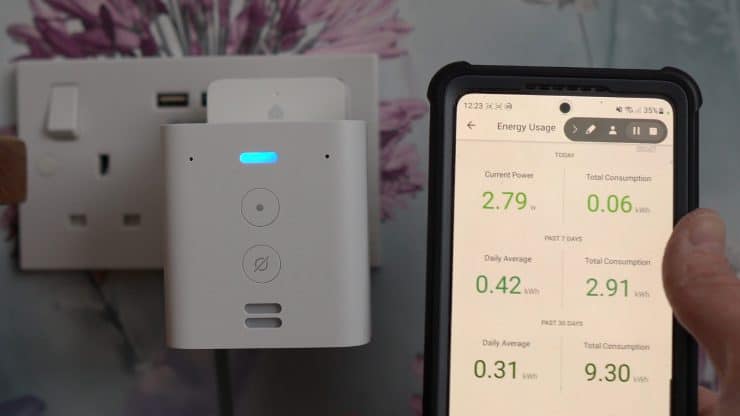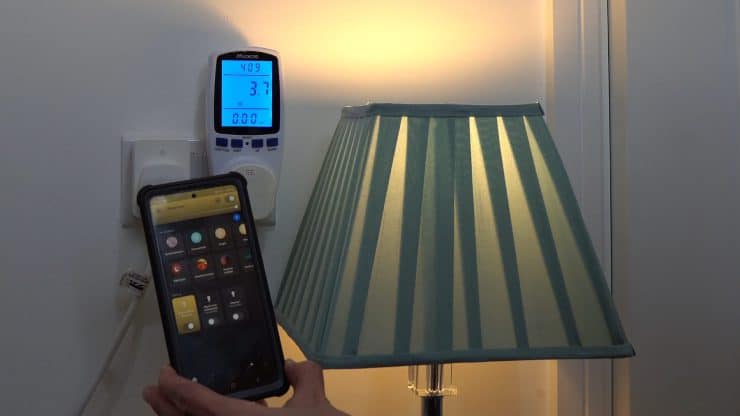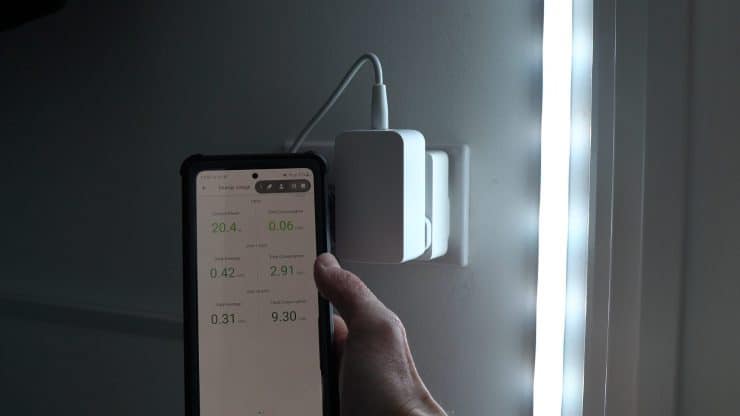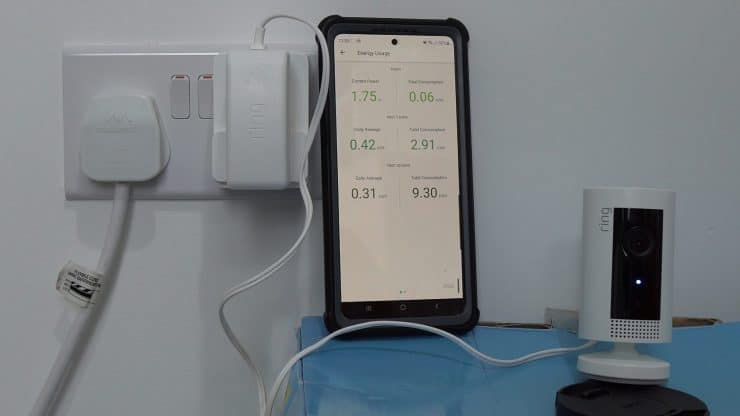I recently had a smart meter installed, which tells me in real time exactly how much energy my house is using. When I put the dishwasher on, for example, it tells me that I’m using £2 per hour – which is good to know (and expensive – bring back lower energy bills, please!).
However after waking up, I also noticed that our household had used 50-60 pence (70 cents) of electricity… without even being awake! I naturally started to wonder if all my smart home devices were causing this energy use. So I went around my house with two energy monitors, and tested a range of smart devices. The results are in my YouTube video:
If you want to calculate your own home’s electric use, check out our calculator below. Also read on for a summary of my own home’s test results, and a transcript/guide of my YouTube video.
Smart Home Electric Use Calculator
The calculator below can help give you an approximate idea of how much electricity (in watts) your smart home uses, and then how much this will cost you each day in America and the UK (using 15¢ per kWh in the US, and 34p per kWh in the UK).
Note: These tools can never be 100% accurate because each type of smart device might use slightly more – or less – energy than the average figures used here. But based on our testing, it gives a fairly accurate representation of your smart home’s electric use.
Energy Usage Summary
The table below shows the highest and lowest energy use I had for each smart device that I tested.
| Smart Device | Energy Use Range |
| Amazon Echo Flex | 1.5-3 watts |
| Amazon Echo Show 8 (2nd Gen) | 4.5-9 watts |
| Amazon Echo 2nd Gen | 2-4 watts |
| Amazon Smart Plug | 0.8-1.4 watts |
| Philips Hue Smart Plug | Up to 0.6 watts |
| Philips Hue Bridge | 1-2 watts |
| Philips Hue Candle White Ambiance Bulb | Up to 4 watts |
| Philips Hue Indoor Lightstrip | Up to 20 watts |
| Philips Hue Outdoor Lightstrip | Up to 40 watts |
| Philips Hue PC Gradient Lightstrip 27″ | Up to 15 watts |
| Google Nest Mini | 1.5-2 watts |
| Ring Chime | 0.5 watts |
| Ring Alarm Base Station | 3 watts |
| Ring Indoor Cam | 1-2 watts |
| TP-Link Tapo Mini Indoor Camera | 1-2 watts |
| Blink Mini Indoor Cam | 0.6-1.2 watts |
| SwitchBot Pan & Tilt HD Cam | 2-3 watts |
Video Transcript & Guide
Hello, I’m Tristan. It may surprise you to learn that power bills have been a tincy wincy little bit high recently…
Alright here we go: 75 at 75, 75 got a bid, 100 now, 100 now, 125 bid 125 now
Uh… yeah. So due to soaring energy bills, I decided to see exactly how much electric my smart home uses. To do this, I tested out a few different energy monitors, and I ended up using my Kasa smart plug which has built-in energy monitoring. It’s surprisingly accurate, and it goes down to half a watt – meaning even quite low power devices can be tested.
Okay, let’s take a look at the results and spoiler alert, I was genuinely surprised at Philips Hue’s power use – but before looking at those, I wanted to quickly cover my four Amazon products first.
Amazon Product Testing

So the first item I tested was the Amazon Echo Flex and it always uses a similar amount of energy, which is around 2 to 3 Watts, whether you’re playing music or it’s in standby mode, it doesn’t vary all that much: maybe by half a watt, so this is very energy efficient.
Next up is the Amazon Echo Show, this is an 8-inch model, the 2nd gen, and it uses around 6-8 watts after starting up. I wanted to also test putting the screen off. This device has a lot of features to turn the screen off at night, for example, and this does go down to 4 to 5 and a half watts. So it does save some energy if the screen is off, which is good to know. Then if the screen is back on, if you play music or you watch a YouTube videos it goes at around 7 watts – which is fairly energy efficient. I was half expecting this device to use a lot more energy to be honest. The maximum power use I could get out of the Echo show was when I did a drop-in mode and this used up to 9 watts, which again isn’t all that high really.
I also tested my full-size Echo 2nd gen which uses between 2 and 4 watts of electricity.
Finally, I tested the Amazon Smart Plug. When this device is in standby (by clicking the side button), what you notice is it uses close to 1 watt of electricity – which is quite a lot considering it’s not doing anything. It’s in standby mode. And if you then turn it on so it could actually supply a device power, it uses up to one and a half watts which… seems quite high for a device which doesn’t actually do much. It can’t play music or anything like that.
So that’s it for the Amazon devices: they are fairly energy efficient; I was pleasantly surprised at the Echo Show, although the Amazon Smart Plug did use slightly more energy than I thought it would – especially compared to the Philips Hue equivalent.
Philips Hue Energy Use

So next up, I tested the Hue Smart Plug, and this is more energy efficient. It actually uses less than half a watt when it’s in standby mode. I then put it on, and it uses just over half a watt, which is pretty good. It might be because this is ZigBee which is slightly more energy efficient than Wi-Fi (which the Amazon smart plug uses). It’s worth bearing this in mind if you want a lot of smart plugs.
Next you’ve got the Philips Hue Bridge: I tested a few different things, playing Lab Formulas, and it didn’t really go over 2 watts. So this is quite an efficient ZigBee-based hub, which is good to know because I have got quite a lot of Hue devices and accessories hooked up to this, and it’s still not using much energy.
Next I’ve got a dimmed down Philips Hue White Ambiance Candle Bulb and it uses around 2 watts even though it’s at 70% brightness, which is good. If you then put it to 100% brightness is used a bit more but only around 4 watts, which is still fairly energy-efficient.
Next up we have the Philips Hue Indoor Lightstrip which, when it’s in color mode, only uses around 2 watts. If I put this up to 100% brightness at green it then uses slightly more, around 7 or 8 watts at peak. What you will notice with any of the RGB Color devices from Philips Hue is if you put it to white, that’s actually what uses the most energy. So you’re looking at around 20 watts now, which is a decent amount – it’s using a fair amount of electric.

Next up, we have the 5 metre Hue Outdoor Lightstrip and in colour mode it used around 16 to 20 watts of Electric at full brightness, but then if we go over to white – as you probably guess by now – this is going to use more electric. It actually uses 40 watts, which is quite a lot. I know that it’s a 5m lightstrip and it pumps out a fair amount of light, but 40 watts still seems like quite a lot to me, for what is still an LED strip. Then if you change back to colour again as soon as it’s green it will use slightly less power 20 to 22 watts.
The good news here is that at around 10% brightness, you’re looking at less than 3 watts. And that’s quite good to know because yes I know it’s not pumping out much light now, but at night-time it actually looks quite good for ambient lighting and 2 watts is pretty good I think.
Next we have a Hue PC Gradient Strip which at full brightness and white color uses around 15 watts of electricity, but obviously lot of the time this will actually mirror the same colour as what’s on your screen, should we go to blue for example it then use less at around 4 or 5 watts, which is quite energy-efficient actually. When you dim it down, for example to white at 35% brightness, it then uses less than 2 watts.
Overall I was a bit surprised by my Hue devices. While some are low power, the lightstrips used more than I would have expected… although the fact that the Outdoor Lightstrip clearly says “40 watts” should have been a hint to me! But as long as you don’t keep these lightstrips on 24/7, they shouldn’t cost too much to run.
Google Nest Mini Test
I also wanted to quickly test my Google Nest Mini, which is the only Google device I actually have, and this uses around 2 watts which is actually similar to the Amazon Echo Flex. I played music and used different features on it, and it never really went above 2 watts – so this is an energy-efficient device too.
Testing Ring Energy Use

Now onto testing Ring devices. I’ll start off with the Ring Chime and this uses up to half a watt. My monitoring device can’t quite track this below half a watt, but in general it uses up to half a watt as you can see, which is good to know. Next up we have the Ring Alarm Base Station which uses Z-Wave and it’s quite low power: it never uses more than 3 watts. The 2nd gen model contains a built-in router that uses slightly more energy, but neither are massive energy users. Now we’ve got the Ring Indoor Cam which uses between one and two watts, whether it’s recording or in standby mode. Sorry about the dodgy base… whoops, I’m so cool, I’m just smacking this over, but overall this doesn’t use much more than 2 watts.
While I only tested three Ring devices there, you can see that they’re all fairly low power. I was always curious about how much energy a smart camera used, and so I was pleasantly surprised that it used less than a TV in standby mode (which is 1 or 2 watts).
Other Smart Camera Tests
Next up we have a Tapo Indoor Camera and this is similar to Ring’s camera, it’s fairly efficient and uses between 1 and 2 watts of energy. I tested a few different scenarios and I never went over two watts.
The Blink Mini Indoor Camera is actually the most energy-efficient of them all: it never went over 1.2 watts and it’s actually frequently below 1 watt, even when recording, which is quite good. I know it’s not the most powerful of smart cameras but it’s still good to know how energy efficient this is.
Finally we have got the Switchbot Tilt which, when you first turn it on, in startup mode it uses around four watts, which is a decent amount, it… come back, it’s turning around, sorry. But then when it actually fully starts up like now, it goes down to around 2-3 watts so it uses slightly more power than some of the other cameras, but not really by much.
Don’t Shower Anymore

[Calculator in hand] Right, I’ve worked it out. If you own an electric shower and you skip showering for a month, then you can run your entire smart home for a whole DECADE. Noice. [Sniffs] But seriously… while electric showers ARE really expensive, I was pleasantly surprised that many smart home devices used less power than I thought.
Price Examples
The UK currently has a “price cap” (was that dramatic enough?) a “price cap that’s totally NOT a price cap” of 34 pence per kilowatt hour. This means that I am paying 10 pence a day (or 3 pounds a month) for my two Echo Shows. If I went nuts and I had Google 10 Nest Minis and 5 smart cameras, this would cost me around 30 pence a day. And while 9 pounds a month isn’t ultra cheap, if you really needed so many devices, it’s probably worth it in my opinion.
But I was a bit surprised to see how much electric the Philips Hue Lightstrips use. While the usage drops down a lot with RGB colors and when dimming, using 20 to 40 watts at full white brightness surprised me. If I ran my lightstrips for 24 hours a day, I’d be looking at 5 pounds a month for the Indoor Hue Lightstrip and 10 pounds a month for the Outdoor Hue Lightstrip. That seems quite high to me, for a single product.
Thankfully though, you can combine this with the Hue Motion Sensors and have the lightstrips go off automatically after a minute or two if no-one is around. You can also set up schedules in the app to turn the strips off at a set time. This is what I do with all of my Hue lightstrips, and it means the total cost is less than 1 pound a month.
Wrapping Up
That just about wraps up today’s video, I hope you enjoyed it and found it useful. If you did, please click the thumbs up button. Please also subscribe, and click the bell icon – which will notify you when I release a new video. Thank you!

If you have any questions, feedback or suggestions about this article, please leave a comment below. Please note that all comments go into a moderation queue (to prevent blog spam). Your comment will be manually reviewed and approved by Tristan in less than a week. Thanks!